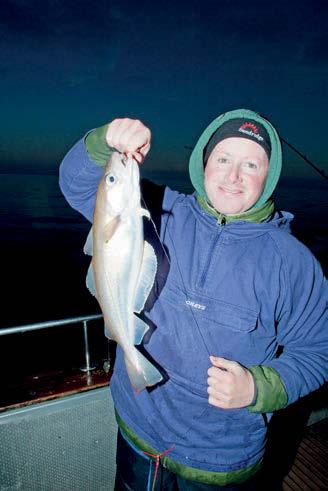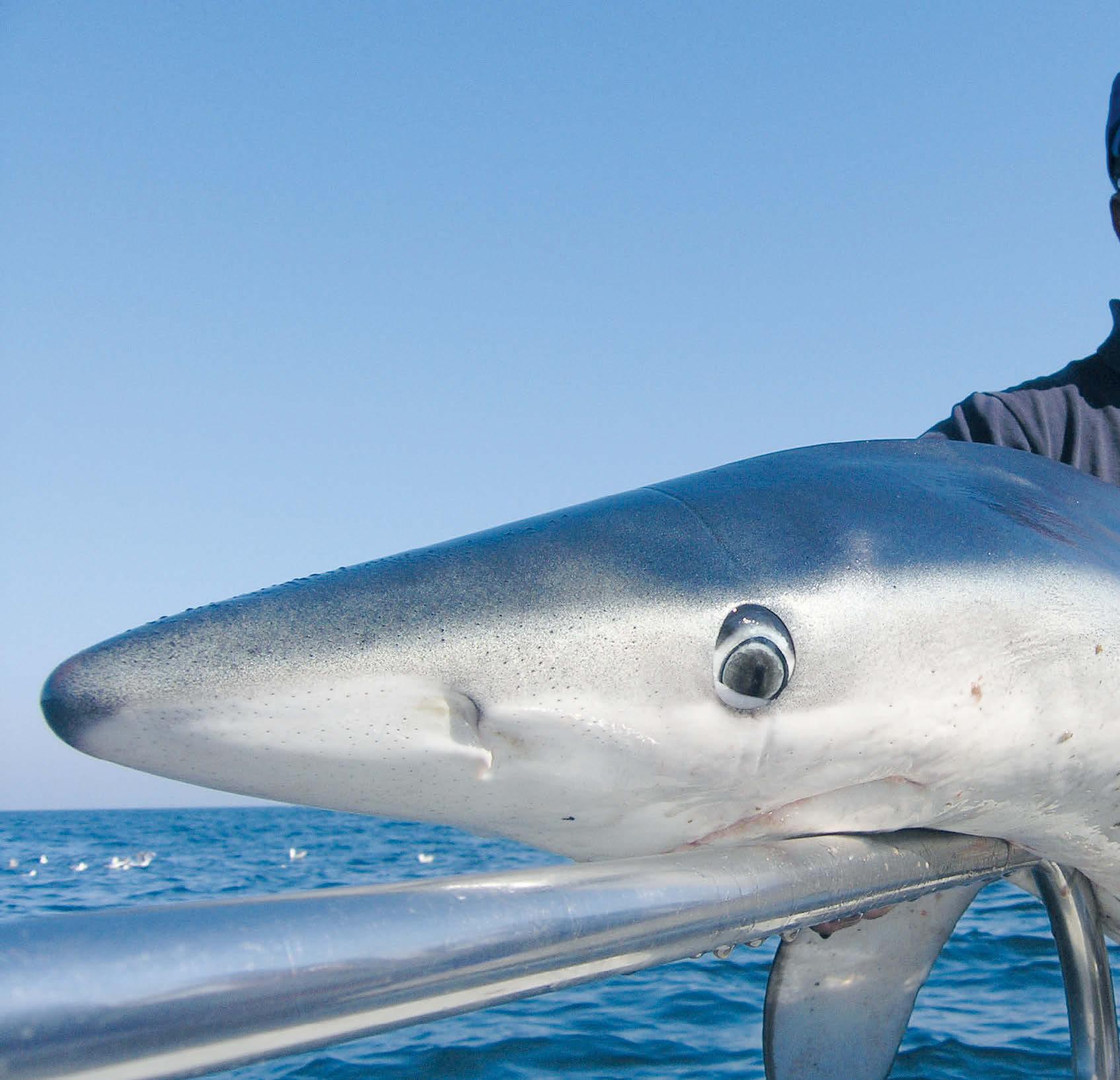
8 minute read
Ballan wrasse
from Sea Angler Guides #5
by KELSEY Media
WRASSE
Few UK sea fish species fight as hard, or as dirty, as a big wrasse, which is why so many anglers love to target them. What’s more, you can target them with both baits and lures
There are five main species of wrasse available from most UK ports – ballan, cuckoo, corkwing, goldsinney and rock cook. e latter three being on the mini-species list as they do not grow over 1lb. en there are two ‘rare’ breeds – the Bailons and scale-rayed wrasse, again both mini species.
However, it’s the mighty ballan wrasse that we are going to focus on because they are the brutes of the family and by far the most widespread and abundant of the species. ey are also the largest, with the British boat record a staggering 9lb 7oz.
Although ballans can be caught throughout the year, if you really want to target a specimen (7lb of more) then late autumn and early winter is the time to do it. Fishing from late August through to December will give you the best chances.

LIGHT TACKLE

To get the best sport when fishing afloat you need the correct tackle. ere is no point fishing conventional boat fishing gear because you’ll struggle to feel the bites and you won’t enjoy the fight anywhere near as much. ere are far too many different makes and models of rods to list here, but as a guide you should be looking at a medium to heavy spinning rod, something like a 9ft 10-40g blank will fit the bill nicely. e choice of reel should be matched to the rod, like a 3000-sized fixed spool reel, loaded with 15lb braid or mono. When using a sensitive rod, where feeling for bites is key, most anglers prefer braid. It works extremely well for wrasse fishing because it allows you to keep in contact
Attractors can play a big part in wrasse fishing. Being mainly sight feeders, wrasse are always on the lookout for a meal. Some anglers like to use a yellow bead above their hooks, just like they do when fishing for black bream. However, red beads also help, as does anything silver.
When wrasse fishing for ballan and cuckoo wrasse use an Aberdeen-style pattern of hook, like the Kamasan B940 or Sukuma Manta in sizes from 1 to 2/0. Although they are strong, these hooks have the ability to bend out of a snag with a little pressure, you can then gently bend them back into position when free – this is common when wrasse fishing.
with the seabed at all times, feeling for the lumps and drops through the rocks. When a wrasse takes your bait you feel an immediate rattle through the braid to the tip of the rod, and then all hell breaks loose!
RIGS & HOOKS
One thing that makes targeting wrasse aboard a drifting boat daunting for many anglers is the possibility of tackle loss. e vast majority of wrasse live among rocks and hard ground, which in turn is often covered in thick weed or kelp – the kind of areas that just eat tackle.
Rigs vary depending on the ground and the wrasse being targeted. A lot of the time I tend to use a simple one-hook paternoster rig, with a rotten bottom weak link to attach my lead. However, in some situations I like to use a one up one down rig, where one hook fishes above the lead and one hook fishes beneath. I use this rig over less tackle-hungry ground, especially when targeting smaller ballans and cuckoo wrasse. e bottom hook, a snood of around 25cm, is tied onto a swivel next to the lead. is hook, along with the lead, are the only items in this set up that make regular contact with the seabed. e next hook is set around 30cm above the lead on a 20cm hook length, which flutters in the tide a short distance above the rocks.
BAITING UP
Wrasse feed on lots of different things including mussel, limpet, prawn and crab, using their front teeth to crush the shells and a second set of teeth to pulverise them. However, one of the most effective baits for catching numbers of wrasse is ragworm which, cut into in 3 cm or 4cm lengths, can be deadly. ese are threaded carefully onto the hook and up the shank, leaving only a small piece trailing. Wrasse are often delicate feeders and will nibble at a bait as it passes by. If your bait is too big, the chances are that when you strike to set the hook, the hook won’t actually be in the wrasse’s mouth. Couple this with an angler’s eagerness to strike at the first signs of a bite, and the wrasse is often missed.
Watch out for those dentures!
When it comes to targeting big ballan wrasse a whole crab bait takes some beating – either peeler crab or plain old hardbacks, or even hermit crabs. e key is to choose a small crab, something that has a main body the size of a ten pence piece.
When using crab baits you’ll quite often feel savage bits, but not connect to the fish. Usually this is because the wrasse is tearing the legs off the crab. To help prevent this, pull all of the legs, bar two, from your baits.
When using hermit crab, whip the legs together with bait elastic, and hook it in such a way that the legs end up pointing up the hook length, with the hook point through the soft body. is works wonders and often results in a hooked fish on the first bite.

FISHING ON THE DRIFT
Unless you are fishing from a big catamaran, where all the anglers are on one side of the boat, the drift will either drag your rig away from the boat, or you will be fishing under the boat. e easiest way to rectify this is to use more lead. is is where using braided main line really helps. If other anglers are using mono and they need 6oz to fish, then you should get away with just 3oz. By doing this you can stay in contact with the seabed and keep your rig fishing straight up and down, which not only increases the chances of you feeling the tiniest of nibbles, but also helps to prevent getting snagged.
Having lowered your rig to the seabed, as the boat drifts slowly over the area, gently lift the rod tip up and then lower it back down again, feeling for the ‘bump’ as your lead connects with the rocks below. e gentlest of movements lifts your bait slowly and allows it to move in the tide, which helps grab the attention of wrasse in and around that area.
Wrasse bites come in two forms – a very slight nibble on the bait which makes the rod tip rattle gently, or a thumping great bite as the wrasse engulfs your bait and makes a run for cover.
If the bites are shy, gently lift your rod tip up slowly and try to encourage the wrasse to hit the bait. If you feel no take from the wrasse after doing this, simply lower the rig back down and repeat.

SOFT PLASTIC SUCCESS
In recent years the soft plastic lure revolution has changed how many anglers fish for wrasse, both from the shore and boat. It has become quite apparent that wrasse have a rubber fetish, and there really is no other method as exciting or as rewarding than when fishing a soft plastic.
Over the years many anglers have found that green lures regularly out-fish any other colour, as has been proven time and time again in Wales and along the South Coast. A close second choice would be brilliant white.

Hermit crabs make excellent wrasse baits from the shore and boat
Probably the most consistent big ballan bait is the good old peeler crab
In some areas, especially the South West, live prawn is the bait of choice for big ballans
As far as lure patterns go, small Fiiish Black Minnows, which have an articulated jighead attached, are great, as were the now discontinued HTO Sea Minnows, which needed to be fished on a fixed jighead.
Most modern soft plastics will catch wrasse. e method is a simple one; in fact, it’s about as basic as lure fishing gets. All you need to do is drop the lure down to the bottom, let slowly lift and drop the lure just a foot or so, making sure that each time you bounce the jig on the seabed below. You can flick the rod tip to impart a little more action into the lure if you wish, which can sometimes help trigger a wrasse to attack. e one thing that this form of fishing gives you that fishing with a baited rig does not, is a direct line to the fish, with no extra lead weight swinging around. e fight is much more intense and direct when lure fishing, and if you’ve never tried it we urge you to give it a go – you will be hooked from your first fish, we can assure you of that! n


The HTO Sea Minnow is a killer wrasse lure

Another wrasse falls for the Black Minnow











